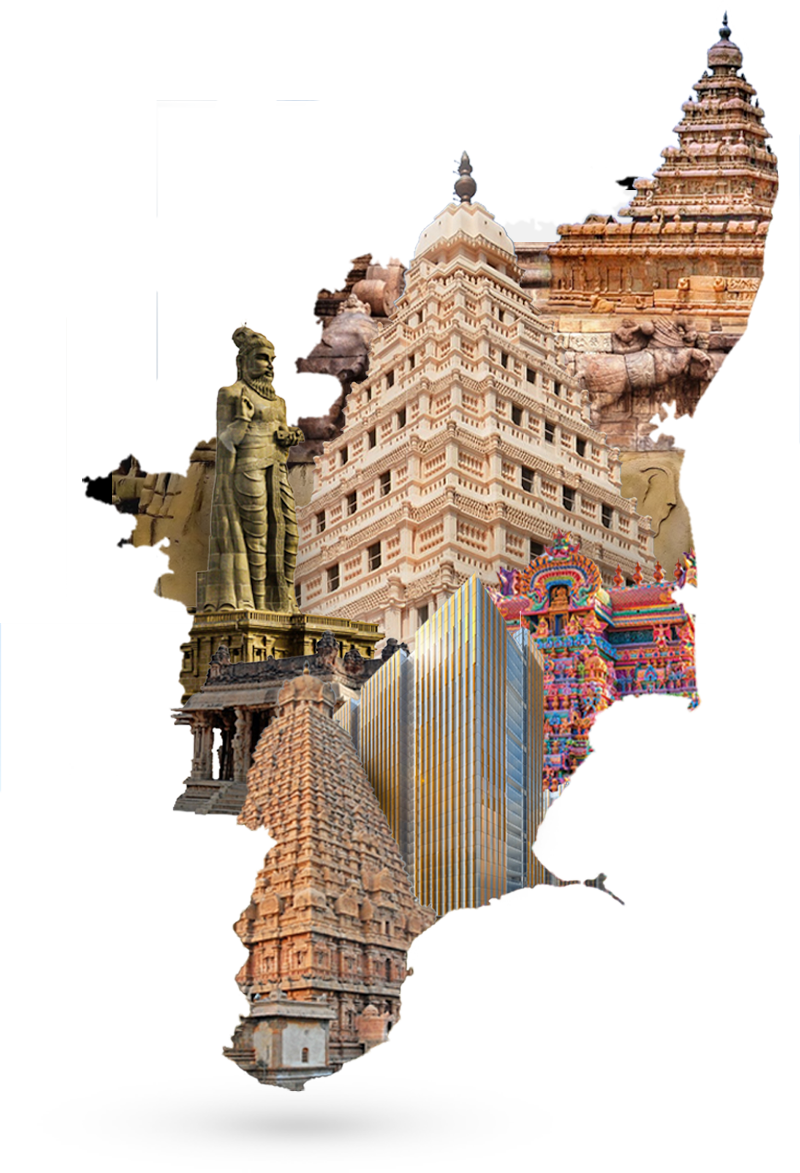- Culture: Tamil Nadu has an incredibly rich cultural heritage. It is part of the famed Dravidian Family, which is recognised as one of the world’s oldest civilizations. Tamils, like other South Indians, take great pride in their deeply established culture and fight tirelessly to maintain their ancient legacy. Its rulers of yore created the famed architecture and art that are preserved today.
- Language: Tamil is the official language of Tamil Nadu since it is spoken by the majority of the population. Tamil is a Dravidian language that is spoken by people all over the world. Because of its autonomous history, great ancient literature and historical origins, the language is recognised as one of the 22 scheduled languages in the Indian Constitution and regarded as a classical language of India. The language is the heir to an enthralling body of ancient literature and is the oldest and longest-surviving classical language still in use.
- Pongal Festival: Pongal is the most prominent and well-known cultural event in the State. The thanksgiving festival, which is held in January, is also the State’s harvest festival. The event lasts four days, with each day having a different significance. Bhogi is the first day, followed by Surya Pongal on the second day. The famous jallikattu takes place on Mattu Pongal, the third day of the festival, and the celebrations conclude on Kaanum Pongal.
- Music and Dance: Carnatic music is the most significant component of Tamil Nadu’s music culture. One of the oldest musical traditions practised today, it is known as Southern Indian Classical Music. Tamil Nadu gave to the world its own musical instrument – the nagaswaram. This is the most popular classical music instrument in South India. The State also gave rise to some of the most beautiful and alluring dance forms. Bharatanatyam is arguably the most appreciated dance form in Tamil Nadu and has gained fans from all over the world. One of India’s earliest dance styles, Bharatanatyam, is recognised as the mother of all other classical dance forms.
- Arts and Crafts: Tamil Nadu, hailed as the cultural capital of India, stands as an epitome of artistic excellence. It takes immense pride in its rich cultural heritage, emphasising its magnificent temples and architectural wonders that serve as timeless testimonies to the artistry and craftsmanship of its people. The art and handicraft culture of Tamil Nadu has been meticulously preserved and passed down through generations, embodying the essence of tradition, skill and spirituality.
Among the myriad art forms that Tamil Nadu is celebrated for, Tanjore painting takes centre stage. It is a masterpiece that symbolises the State’s cultural richness, blending artistic skill, age-old tradition and spiritual depth. The Tanjore painting is not merely a canvas; it is a cultural legacy that resonates with the soul and captivates the senses.
In the realm of textiles, Tamil Nadu is renowned for its Kancheepuram silk sarees, which have gained international acclaim for their exquisite craftsmanship and intricate handwoven designs. The delicate patterns and masterful weaving make these sarees highly sought after, and they are treasured as heirlooms that epitomise the artistry of the region’s weavers. Mastery and artistry in weaving extends to sarees produced in places like Thirubuvanam, Salem, Chinnalapatti and Arni. The Sungidi sarees of Madurai, which preserve an ancient tie-and-dye tradition, are popular all over the world.
Tamil Nadu’s artistic heritage also includes a rich tradition of stone carvings and granite figurines, unearthed from archaeological sites. These artefacts serve as an irreplaceable treasure, showcasing the exceptional craftsmanship of Tamil artisans through the ages. The legacy of bronze casting, pioneered during the reign of the Chola dynasty, continues to thrive, producing unique bronze icons that are revered and cherished as souvenirs, reflecting the cultural roots of the land. Artisans involved in making icons are concentrated around Swamimalai.
Papier-mache handicrafts and Tanjore’s Appliqué work are prominent expressions of artistry in Tamil Nadu, adding to the diverse tapestry of artistic endeavours within the State. These crafts are showcases of the creativity and ingenuity of the artisans.
Crafting musical instruments is a significant craft practised by the people, with instruments like veena, tambura and flute being crafted from materials like bamboo, bronze and sandalwood. These instruments, beyond their musical quality, showcase the exceptional craftsmanship and dedication of the artisans.
Historical records, including writings by eminent scholars like Kautilya and Pliny, bear testament to the praise bestowed upon Tamil Nadu’s craftsmanship. The soft muslin, fine silk, exquisite ivory work and precious gemstones crafted in the State have garnered admiration from scholars and connoisseurs alike. These accolades further highlight the State’s immense artistic prowess and its substantial contribution to India’s rich and diverse cultural heritage.
- Architecture: Tamil Nadu is renowned for its Dravidian architecture, which is found in its ancient temples. This architecture was created by indigenous people and evolved through time. The oldest instances of Tamil Dravidian architecture date to the seventh century. Academics contend that the absence of monuments in South India prior to the 7th century was due to timber temples that finally fell victim to natural disasters. The Pallava Epoch, the Early Chola Epoch, the Later Chola Epoch, the Vijayanagara/Nayak Epoch and the Modern Epoch are the five major epochs in Tamil Nadu during which the temple design evolved. There are 38,615 temples in Tamil Nadu, where most of the largest Hindu temples are located.

